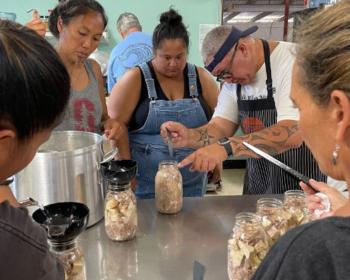
Let’s face it, Indigenous Peoples are all but irrelevant in most people’s lives. The biggest news on Indigenous Peoples lately is whether or not the Washington Redskins will change their name. Roger Goodell, NFL Commissioner, and Redskins owner Dan Snyder are trying to spin “Redskins” as a “unifying force that stands for strength, courage, pride and respect.” Why? Because Forbes calculates the value of the Redskins brand to be $131 million. Changing the name of one of sports’ most valuable brands would cost millions. Who would have thought that Native Americans could have such an impact on a company’s bottom line?
In fact, Indigenous Peoples across the world are one of the fastest growing risk factors impacting corporate profits, especially those in extractive industries. As oil, gas and mining companies explore the globe for new production sites, they are finding those resources on or near Indigenous Peoples’ land. In the past, that didn’t matter much. For the right price, governments cleared the people away, rented or sold the land, and companies profited handsomely. But now, it’s not that easy.
The investment risk associated with not respecting Indigenous Peoples’ rights is real and growing. The oil industry is holding its collective breath over Chevron’s $18 billion case in Ecuador. Indigenous Peoples sued Texaco, which was bought by Chevron in 2001, for faulty drilling practices that damaged wide areas of the Amazon in the 1970s and 1980s. In February 2008 the Ecuadorian court found Chevron guilty and fined the company $8 billion, which was increased to $18 Billion after Chevron’s refusal to pay. This ruling was upheld in 2012 and the Ecuadorian court froze $200 million worth of Chevron’s assets for continued refusal to compensate Indigenous communities.
Some of Chevron’s shareholders are not happy and responded with a letter questioning, “whether the company’s leadership can properly manage the array of environmental and human rights challenges and risks that it faces.” A week later, 38 percent of Chevron’s shareholders voted in favor of a resolution reprimanding CEO John Watson for his handling of the Ecuador situation, and some have gone so far as to ask the Securities and Exchange Commission (SEC) to investigate the company for misleading investors.
Chevron is not an isolated case. In 2012, Talisman Energy became the fifth oil company to withdraw operations from Block 64 in the Peruvian Amazon because of resistance from the Achuar and other Indigenous Peoples. Now Peru’s state oil company Petroperu is trying its luck, but they are facing continued Indigenous protests. “We have opposed all the companies here, beginning with Arco, then Occidental and most recently Talisman,” wrote one Achuar organization in a letter to Peruvian president Ollanta Humala. “Like we did for all of those, we will make it impossible for Petroperu to enter.”
The costs are not limited to court fines and abandoned projects. John Ruggie of Harvard University and the U.N.’s Special Representative for Business and Human Rights found that delays were a major cost for companies, calculating that it costs a company $20-30 million when a community protest shuts down a world-class mining operation for a week. And delays are increasing in the industry. In 2008, a Goldman Sachs study found that the time it takes an oil project to come online has doubled over the last decade. The reason?73 percent of the delays came from “above ground” or non-technical risks. Translation: unhappy communities are quickly driving up project costs.
The reality is Indigenous Peoples are not going away and extractive companies are going to encounter them more and more. An upcoming report by First Peoples Worldwide that reviews the operations of 40 U.S. oil and gas companies from the Russell 1000 found that over 30 percent of these companies’ current worldwide production takes place on or near Indigenous Peoples land. That figure jumps to over 50 percent when considering future reserves. The numbers are even higher for mining companies, rising to over 40 percent for current projects and near 80 percent for future projects.
How did Indigenous Peoples go from invisible to a major risk factor? Over the last few decades Indigenous Peoples have learned how to use international and domestic legal systems to their advantage. For decades they fought for official recognition at the United Nations and for the right to have Free, Prior and Informed Consent (FPIC) over actions and development projects undertaken on their land. In 2007 they received it in the Declaration of the Rights of Indigenous Peoples (UNDRIP). Knowing they needed more teeth than international law could provide, Indigenous Peoples then fought with increasing success to get UN member states to pass UNDRIP-inspired laws at home.
But Indigenous Peoples also realized profit and loss statements can be more powerful than international law in achieving their goals. They began working with shareholders to pressure corporate boards to consider the costs of ignoring Indigenous Peoples’ rights. In 2007, they successfully worked with the shareholders of Newmont Mining, who voted overwhelmingly (91.6 percent) to direct the company to assess the ways it could strengthen its policies and practices to resolve and avoid community opposition to its projects.
The result? Extractive companies worldwide are racing to define their policies for working with Indigenous Peoples, and Indigenous Peoples are familiarizing themselves with how to use FPIC to their advantage. The losses Dan Snyder and the Redskins face pales in comparison with what extractive companies will experience if they ignore the rights of Indigenous Peoples.
But there is a better way. Just as Snyder could embrace change and work with Native Americans to find a new name that respects Native Americans and preserves the brand equity of his franchise, companies can work with Indigenous Peoples to forge win-win relationships where both shareholders and Indigenous communities achieve their short and long-term goals.



